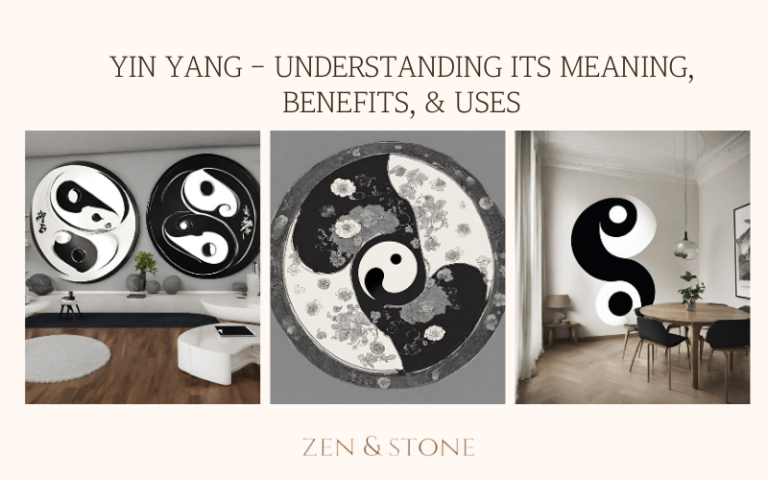Yin Yang is a concept that has been around for thousands of years and is deeply rooted in Eastern philosophy. It is a symbol of the dualistic nature of the universe, where everything is composed of two opposing yet complementary forces. Yin represents the feminine, passive, and dark aspects of nature, while Yang represents the masculine, active, and light aspects.
The origins of Yin Yang can be traced back to ancient Chinese philosophy, where it was used to explain the nature of the universe. It was believed that everything in the world could be classified as either Yin or Yang, and that these forces were in a constant state of flux, always interacting and balancing each other out. Over time, the concept of Yin Yang has been applied to many different areas of life, from traditional Chinese medicine to martial arts.
Today, Yin Yang remains a popular symbol in modern culture, with many people using it to represent the balance and harmony that they strive for in their own lives. Whether you are interested in philosophy, medicine, or simply want to learn more about this fascinating concept, there is much to discover about the meaning and symbolism of Yin Yang.
Key Takeaways
- Yin Yang is a concept that represents the dualistic nature of the universe, where everything is composed of two opposing yet complementary forces.
- The origins of Yin Yang can be traced back to ancient Chinese philosophy, where it was used to explain the nature of the universe.
- Today, Yin Yang remains a popular symbol in modern culture, representing balance and harmony.
Origins of Yin Yang
The concept of Yin Yang has its roots in ancient Chinese philosophy and cosmology. It is believed to have originated in the School of Yin Yang, which was a group of scholars who studied the natural world and the relationship between different phenomena.
One of the earliest known references to Yin Yang is in the Book of Changes (I Ching), which is a Chinese divination text dating back to the Western Zhou dynasty (1046–771 BCE). In this text, Yin and Yang are described as two opposing but complementary forces that give rise to all things in the universe.
The philosopher and cosmologist Zou Yan (305–240 BCE) is credited with developing the concept of Yin Yang into a comprehensive system of thought. He believed that everything in the universe could be classified into one of five elements (wood, fire, earth, metal, and water), which were themselves governed by the principles of Yin and Yang.
Over time, the concept of Yin Yang became deeply ingrained in Chinese culture and was incorporated into various aspects of life, including medicine, martial arts, and feng shui. It is still widely studied and practiced today, both in China and around the world.
Philosophical Interpretation
Yin Yang is a concept that has been interpreted in various ways throughout the history of Chinese philosophy. The philosophical interpretation of Yin Yang is based on three main sub-concepts: Dualism, Interdependence, and Dynamic Balance.
Dualism
The concept of Dualism in Yin Yang philosophy is based on the idea that everything in the universe can be divided into two opposing forces, Yin and Yang. These two forces are not only opposing but also complementary. They are like two sides of a coin, and one cannot exist without the other.
Yin is associated with feminine energy, darkness, cold, and passivity, while Yang is associated with masculine energy, light, heat, and activity. However, it is important to note that Yin and Yang are not fixed entities, and they can change and transform into each other.
Interdependence
Interdependence is another sub-concept of Yin Yang philosophy. It refers to the idea that Yin and Yang are not only complementary but also interdependent. They cannot exist without each other, and one cannot be fully understood without the other.
For example, day cannot exist without night, and vice versa. Similarly, life cannot exist without death, and good cannot exist without evil. Interdependence is a crucial aspect of Yin Yang philosophy, as it emphasizes the importance of balance and harmony in all aspects of life.
Dynamic Balance
The third sub-concept of Yin Yang philosophy is Dynamic Balance. It refers to the idea that Yin and Yang are in a constant state of flux and change. They are not static entities, but rather dynamic and ever-changing.
Dynamic Balance emphasizes the importance of maintaining a balance between Yin and Yang. When Yin and Yang are in balance, there is harmony and peace. However, when one force becomes dominant over the other, there is imbalance, which can lead to chaos and disharmony.
Yin Yang Symbolism
The Yin Yang symbol is a well-known representation of Chinese philosophy and culture. It is a circular symbol consisting of two interlocking parts – one black and one white – each containing a small circle of the opposite color. The symbol is often used to represent the concept of duality, the idea that seemingly opposite forces are interconnected and interdependent.
Black and White Swirls
The black and white swirls in the Yin Yang symbol represent the two opposing forces of Yin and Yang. Yin is associated with feminine energy, darkness, passivity, and receptivity. Yang, on the other hand, is associated with masculine energy, light, activity, and creativity. The swirls also represent the idea that these two forces are constantly in motion, flowing and changing in a never-ending cycle.
Dot within the Swirls
The small dot within each swirl represents the seed of the opposite force. This means that within Yin, there is a small amount of Yang, and within Yang, there is a small amount of Yin. This is meant to symbolize the idea that nothing in the universe is completely black or white, but rather exists on a spectrum between the two opposing forces.
Modern Interpretations and Uses

In modern times, the concept of Yin Yang has been applied to a wide range of fields, including psychology, medicine, and design. Here are a few examples of how the concept is being used today:
Psychology
In psychology, the Yin Yang symbol is often used to represent the balance between the conscious and unconscious mind. It is believed that the conscious mind (Yang) and the unconscious mind (Yin) are both necessary for a person to have a healthy and balanced psyche. This idea has been used in various forms of therapy, including cognitive-behavioral therapy and mindfulness meditation.
Medicine
In traditional Chinese medicine, the Yin Yang symbol is used to represent the balance between opposing forces within the body, such as hot and cold, or dry and wet. It is believed that illness arises when these forces become unbalanced, and that restoring balance is key to restoring health. This idea has been incorporated into various forms of alternative medicine, including acupuncture and herbal medicine.
Design
In design, the Yin Yang symbol is often used to represent the balance between form and function. It is believed that a well-designed object must balance these two elements in order to be aesthetically pleasing and functional. This idea has been applied to various fields of design, including architecture, product design, and graphic design.
Conclusion
In conclusion, the Yin Yang symbol is a fundamental concept in Eastern philosophy that represents the duality of the universe. It is a symbol of balance and harmony between opposing forces, such as light and dark, male and female, and good and evil. The symbol is believed to have originated from the ancient Chinese philosophy of Taoism, which emphasizes the importance of balance and harmony in all aspects of life.
The Yin Yang symbol is a powerful reminder of the interconnectedness of all things and the need for balance in our lives. By embracing both the Yin and Yang energies, we can achieve a state of harmony and balance that will help us to live a more fulfilling and meaningful life.
While the concept of Yin Yang may seem simple, it is actually quite complex and multifaceted. It has many different meanings and interpretations, depending on the context in which it is used. However, at its core, Yin Yang represents the idea that everything in the universe is interconnected and that balance and harmony are essential for a healthy and fulfilling life.
Overall, the Yin Yang symbol is a powerful tool for self-reflection and personal growth. By understanding its meaning and embracing its energy, we can achieve a greater sense of balance and harmony in our lives, and ultimately, find greater peace and happiness.
The post Yin Yang – Understanding its Meaning, Benefits, & Uses first appeared on Zen and Stone.

